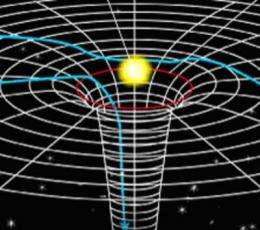Rewriting general relativity? Putting a new model of quantum gravity under the microscope

Does an exciting but controversial new model of quantum gravity reproduce Einstein's theory of general relativity? Scientists at Texas A&M University in the US explore this question in a paper appearing in Physical Review Letters and highlighted with a Viewpoint in the August 24th issue of Physics.
"If it ain't broke, don't fix it," sums up fairly well how many scientists have viewed Einstein's theory of general relativity. The theory, which Einstein developed in the early 20th century, says that matter curves spacetime, and it is this curvature which deflects massive bodies - an effect that we interpret as the influence of gravity. The theory has been tested to extremely high accuracy and without it, our satellite global positioning system would be off by about 10 km per day.
Despite the success of general relativity, one of the most important problems in modern physics is finding a theory of quantum gravity that reconciles the continuous nature of gravitational fields with the inherent 'graininess' of quantum mechanics. Recently, Petr Hořava at Lawrence Berkeley Lab proposed such a model for quantum gravity that has received widespread interest, in no small part because it is one of the few models that could be experimentally tested. In Hořava's model, Lorentz symmetry, which says that physics is the same regardless of the reference frame, is violated at small distance scales, but remerges over longer distance scales
The team at Texas A&M, which includes Hong Lu, Jianwei Mei and Christopher Pope, report their investigations into how the modifications proposed in Hořava's theory will broadly affect the solutions of general relativity. One aspect of their study is that it leads to an important caveat, described by Horatiu Nastase in a Viewpoint commentary in Physics. Lu et al.'s calculations, explains Nastase, suggest that Hořava's model only reproduces general relativity on unobservable scales, "larger than the size of the Universe".
Lu et al.'s paper is an important contribution to testing the Hořava model and shows that a good deal of work remains to understand its full implications.
More information: link.aps.org/doi/10.1103/PhysRevLett.103.091301; Download PDF (free)
Source: American Physical Society

















